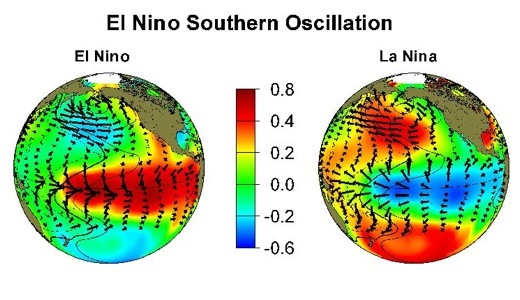SUBHEAD: Expect Climate Change to whipsaw between hot, dry En Nino and cold, wet La Nina.
By Jan TenBruggencate on 28 January 2015 for Raising Islands -
(http://raisingislands.blogspot.com/2015/01/expect-climate-change-to-whipsaw-hawaii.html)

Image above: Detail of illustration on El Nino and El Nina oscillation. From U.C. Davis. (https://watershed.ucdavis.edu/skeena_river/documents/initial_reports/SKhanna.pdf).
El Nino and La Nina events could be more frequent and much stronger with climate change.
That’s according to a new analysis published this week by an international team that includes Hawai`i researcher Axel Timmermann, of the International Pacific Research Center at the University of Hawai`i.
It’s important to Hawai`i residents because those climate variances have significant impacts on rainfall patterns, storm, water temperature and other things. One issue: more drought during El Nino events and more heavy rain events during La Nina—essentially, Hawai`i during the coming decades can expect to be whipsawed between more extreme weather events.
"Our previous research showed a doubling in frequency of extreme El Niño events, and this new study shows a similar fate for the cold phase of the cycle. It shows again how we are just beginning to understand the consequences of global warming,” said Mat Collins, a University of Exeterprofessor and co-author of the new paper.
Increased frequency of extreme La Niña events under greenhouse warming was published in the journal Nature Climate Change. Its authors, besides Collins and Timmermann, are Wenju Cai, Guojian Wang, Agus Santoso, Michael J. McPhaden, Lixin Wu, Fei-Fei Jin, Axel Timmermann, Gabriel Vecchi, Matthieu Lengaigne, Matthew H. England, Dietmar Dommenget, Ken Takahashi & Eric Guilyardi
Timmermann echoed Collins’ comments.
He said the study is based on an analysis of 21 existing climate models.
The paper’s summary says:
“Here we present climate modelling evidence… for a near doubling in the frequency of future extreme La Niña events, from one in every 23 years to one in every 13 years.
“This occurs because projected faster mean warming of the Maritime continent than the central Pacific, enhanced upper ocean vertical temperature gradients, and increased frequency of extreme El Niño events are conducive to development of the extreme La Niña events.
“Approximately 75% of the increase occurs in years following extreme El Niño events, thus projecting more frequent swings between opposite extremes from one year to the next.”
.
By Jan TenBruggencate on 28 January 2015 for Raising Islands -
(http://raisingislands.blogspot.com/2015/01/expect-climate-change-to-whipsaw-hawaii.html)

Image above: Detail of illustration on El Nino and El Nina oscillation. From U.C. Davis. (https://watershed.ucdavis.edu/skeena_river/documents/initial_reports/SKhanna.pdf).
El Nino and La Nina events could be more frequent and much stronger with climate change.
That’s according to a new analysis published this week by an international team that includes Hawai`i researcher Axel Timmermann, of the International Pacific Research Center at the University of Hawai`i.
It’s important to Hawai`i residents because those climate variances have significant impacts on rainfall patterns, storm, water temperature and other things. One issue: more drought during El Nino events and more heavy rain events during La Nina—essentially, Hawai`i during the coming decades can expect to be whipsawed between more extreme weather events.
"Our previous research showed a doubling in frequency of extreme El Niño events, and this new study shows a similar fate for the cold phase of the cycle. It shows again how we are just beginning to understand the consequences of global warming,” said Mat Collins, a University of Exeterprofessor and co-author of the new paper.
Increased frequency of extreme La Niña events under greenhouse warming was published in the journal Nature Climate Change. Its authors, besides Collins and Timmermann, are Wenju Cai, Guojian Wang, Agus Santoso, Michael J. McPhaden, Lixin Wu, Fei-Fei Jin, Axel Timmermann, Gabriel Vecchi, Matthieu Lengaigne, Matthew H. England, Dietmar Dommenget, Ken Takahashi & Eric Guilyardi
Timmermann echoed Collins’ comments.
“Our recent study in Nature Climate Change demonstrates that extreme La Nina events are likely to become more frequent over the next 100 years. Many of these events will follow stronger El Nino events.""This means for Hawaii that the transitions between El Nino and La Nina are likely to result in larger year-to-year rainfall extremes - extra drought during El Nino and extreme winter rain for La Nina,” Timmermann said.
He said the study is based on an analysis of 21 existing climate models.
The paper’s summary says:
“Here we present climate modelling evidence… for a near doubling in the frequency of future extreme La Niña events, from one in every 23 years to one in every 13 years.
“This occurs because projected faster mean warming of the Maritime continent than the central Pacific, enhanced upper ocean vertical temperature gradients, and increased frequency of extreme El Niño events are conducive to development of the extreme La Niña events.
“Approximately 75% of the increase occurs in years following extreme El Niño events, thus projecting more frequent swings between opposite extremes from one year to the next.”
.
No comments :
Post a Comment